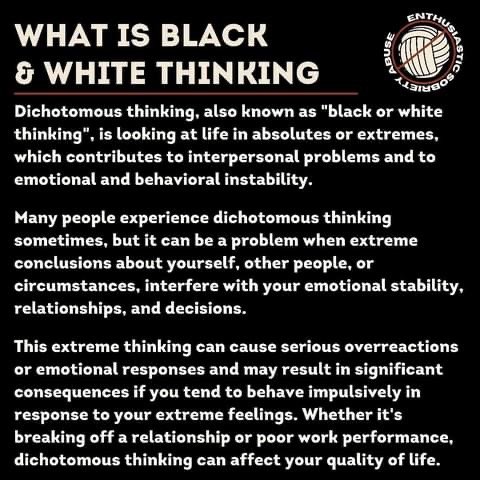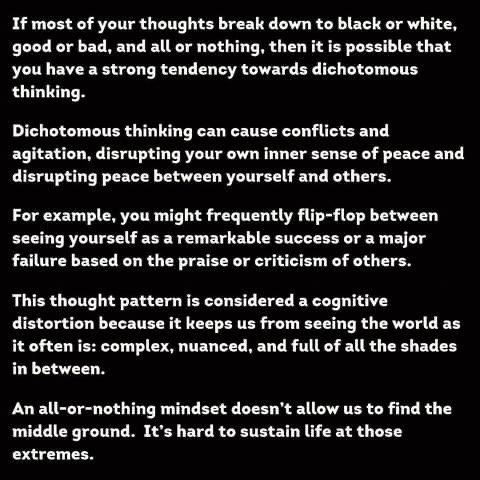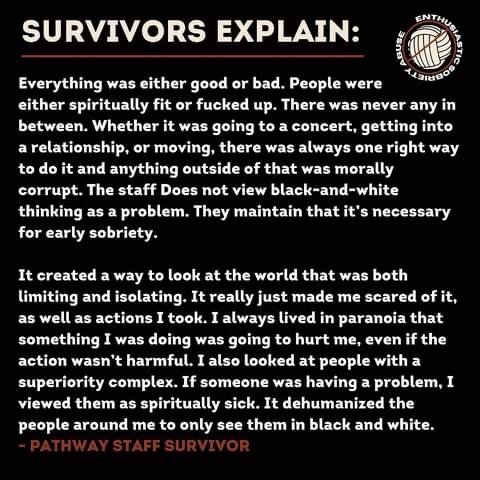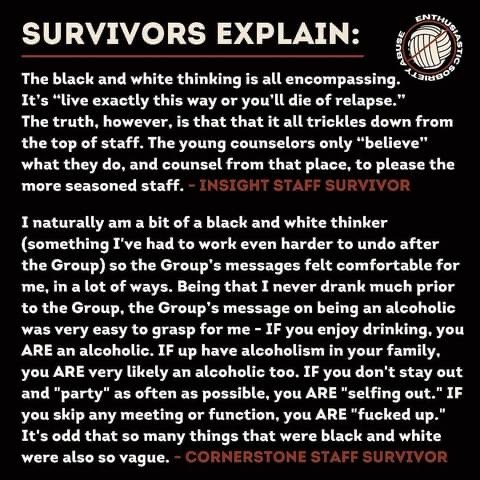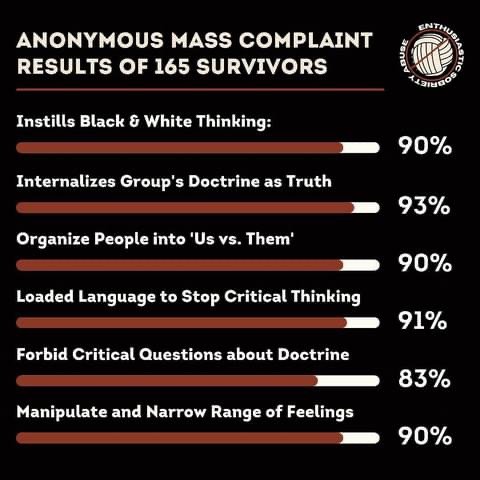Dangers of Black and White Thinking
Black and white thinking, also known as dichotomous thinking or all-or-nothing thinking, is a cognitive pattern where individuals perceive situations, people, or ideas as being either completely one way or the other, without considering the middle ground or nuances. It involves categorizing things into rigid and extreme categories, often ignoring the complexities and shades of gray that exist in between.
How Cults Use Black and White Thinking:
Cults often exploit black and white thinking as a manipulative tactic to control their members' beliefs, behaviors, and loyalty. Here's how they use it:
Polarization: Cults create a strong sense of "us-versus-them" mentality by presenting their beliefs as the only right way, while portraying anyone outside the cult as misguided, evil, or inferior.
Absolute Loyalty: Cults demand unwavering loyalty to their leader and teachings, making it seem like there is no room for questioning or dissent.
Fear of Consequences: Members are led to believe that straying from the cult's beliefs or rules will result in dire consequences, reinforcing the idea that there is only one correct path.
Blacklisting Dissent: Anyone who questions or expresses doubt is labeled as a traitor, heretic, or enemy. This discourages critical thinking and open discussions.
Cognitive Distortions: Cults use cognitive distortions, including black and white thinking, to manipulate members' perception of reality, making it difficult for them to see any other perspective.
Dangers and Consequences on Black and White Thinking:
While this type of thinking can be a natural cognitive shortcut, it can also have several dangers and negative consequences:
Limited Perspective: Black and white thinking oversimplifies complex situations, ignoring the many shades of gray that exist in between. This limits your understanding of the world and prevents you from considering multiple viewpoints.
Lack of Flexibility: Viewing things in absolutes can lead to inflexibility in adapting to changing circumstances. Life rarely fits neatly into two categories, and rigid thinking can hinder your ability to adjust and find creative solutions.
Impaired Problem Solving: Complex problems often require nuanced analysis and consideration of multiple factors. Black and white thinking can prevent you from recognizing subtle details that could be crucial to solving issues effectively.
Relationship Strain: Applying black and white thinking to people can lead to unrealistic expectations and strained relationships. People are multidimensional, and labeling them as either completely good or bad ignores their complexities.
Emotional Distress: Extremist thinking can lead to heightened emotions. Perceiving every situation as a catastrophe or a complete triumph can contribute to anxiety, stress, and mood swings.
Cognitive Rigidity: Black and white thinking contributes to cognitive rigidity, making it harder to adapt to new information, learn from experiences, and grow intellectually.
Self-Criticism: Applying this thinking to oneself can lead to low self-esteem. Viewing oneself as either a complete success or a total failure ignores the reality that everyone makes mistakes and has strengths and weaknesses.
Us-Versus-Them Mentality: Dichotomous thinking can lead to polarization and an "us-versus-them" mentality, which is detrimental to effective communication, collaboration, and understanding between groups.
Missed Opportunities: Seeing things in absolutes can cause you to overlook opportunities for growth, compromise, or collaboration that fall outside your predetermined categories.
Inaccurate Perceptions: Black and white thinking can lead to inaccurate perceptions of reality. For example, seeing an entire group as hostile because of the actions of a few individuals ignores the diversity within that group.
Binary Decision-Making: This thinking style can limit your decision-making by forcing you to choose between only two options, ignoring potential middle-ground solutions.
Pessimism and Optimism Extremes: Black and white thinking can lead to unrealistic optimism or pessimism. Situations are rarely either completely positive or entirely negative, and such thinking can skew your outlook on life.
Changing Black and White Thinking
To counter the dangers of black and white thinking, it's important to cultivate cognitive flexibility, open-mindedness, and a willingness to embrace complexity. Recognizing the shades of gray between extreme categories allows for a more nuanced understanding of the world and helps you make better-informed decisions. Overcoming black and white thinking involves cultivating cognitive flexibility and embracing shades of gray. Here's how you can work towards changing this thinking pattern:
Awareness: Recognize when you're engaging in black and white thinking. Pay attention to situations where you're labeling things as either completely good or bad.
Challenge Extremes: Whenever you catch yourself thinking in absolutes, challenge those extreme viewpoints. Ask yourself whether there could be a middle ground or alternative perspective.
Seek Complexity: Train yourself to see the nuances in situations. Consider the factors and variables that contribute to a situation rather than simplifying it.
Practice Perspective-Taking: Put yourself in others' shoes and try to understand their viewpoints. This can help you appreciate the diversity of opinions and experiences.
Embrace Uncertainty: Acknowledge that the world is complex and not always easily categorized. Embrace the idea that it's okay not to have all the answers.
Use Qualifiers: Incorporate words like "sometimes," "usually," "often," and "maybe" into your thoughts and speech to express uncertainty and openness to different possibilities.
Challenge Cult-Like Thinking: If you've been exposed to black and white thinking in a cult or other manipulative environment, seek support from friends, family, or mental health professionals to help you reevaluate your beliefs.
Practice Mindfulness: Mindfulness techniques can help you become more aware of your thought patterns and allow you to pause before jumping to extreme conclusions.
Changing black and white thinking takes time and effort, but it can lead to a more balanced, open-minded, and adaptive way of viewing the world. It allows you to navigate complex situations with greater clarity and understanding.
Resources
How Black and White Thinking Hurts You (and What You Can Do to Change It)
The Role of Cognitive Distortion
How Does Black-and-White Thinking Affect Your Mood and Behavior?
Dichotomous Thinking and Borderline Personality Disorder


